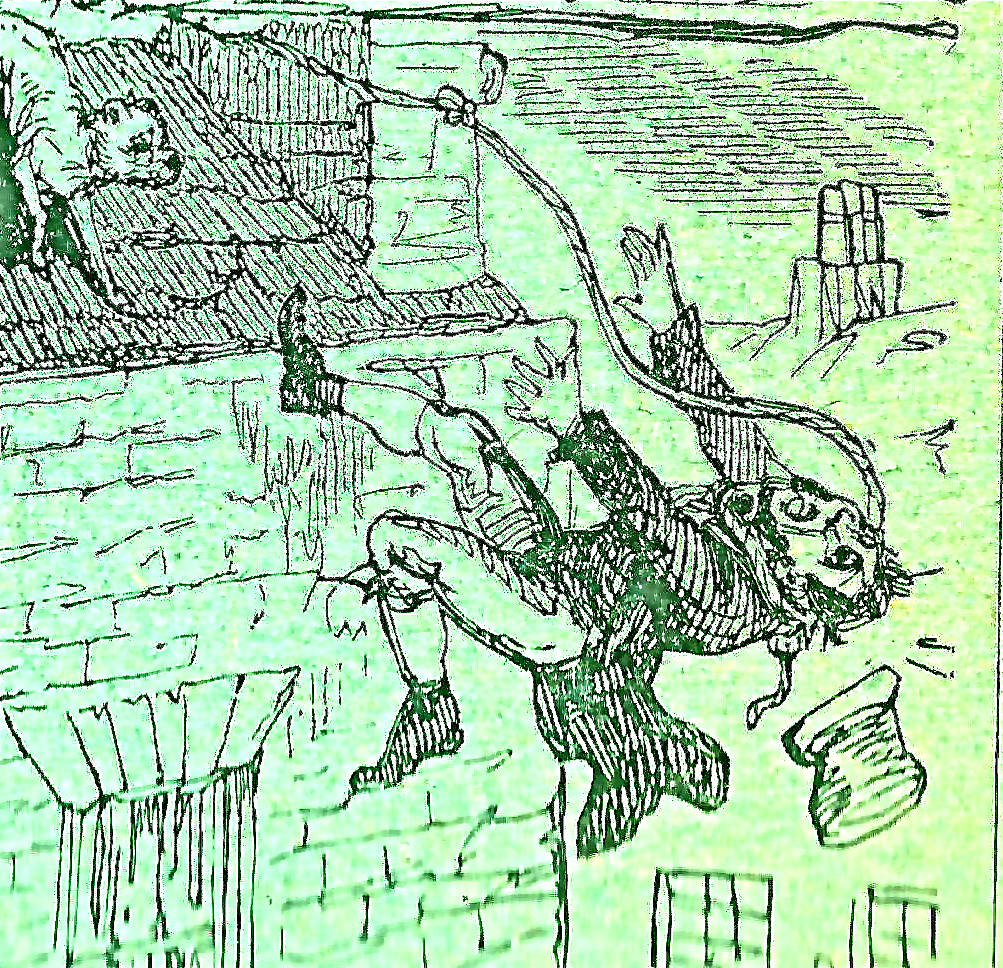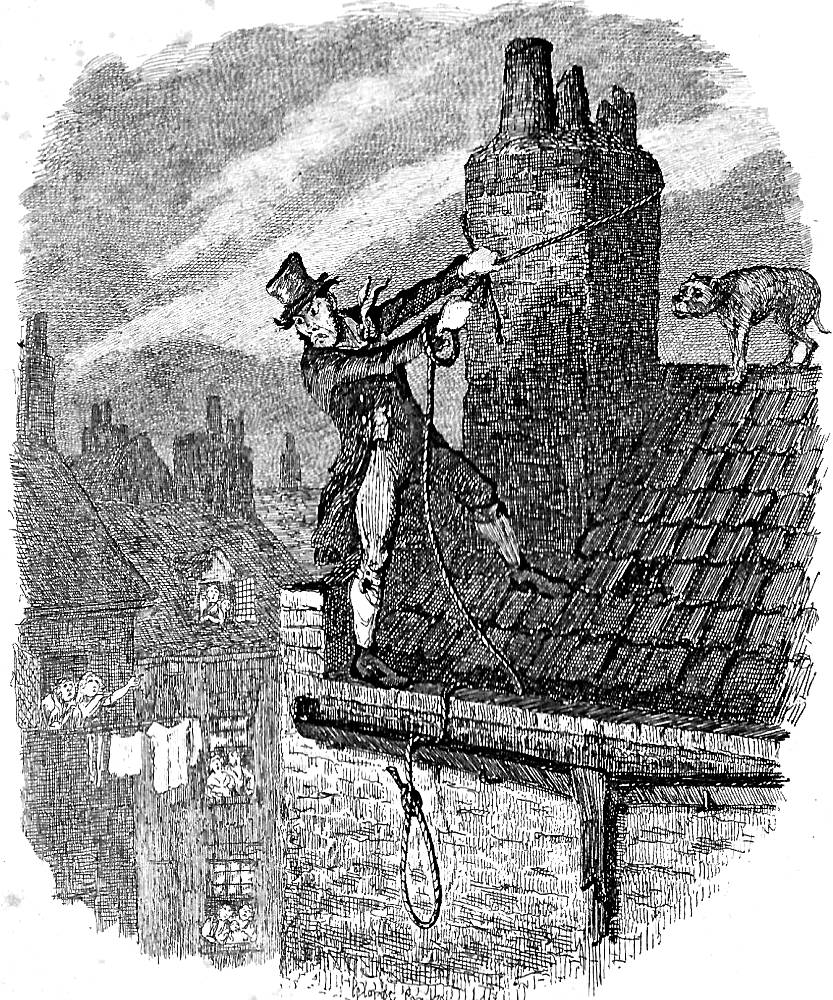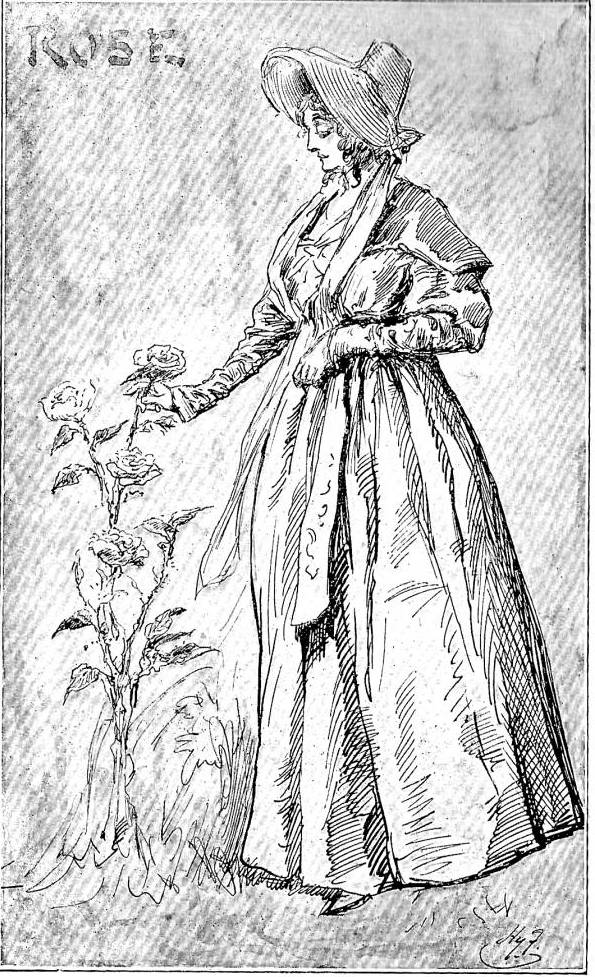
"And creeping over the tiles, looked over the low parapet." — James Mahoney's thorough revision of Sikes trapped in Chapter 50 on the rooftop of Toby Crackit's safehouse on Jacob's Island in the Household Edition. In the original narrative-pictorial serial sequence by George Cruikshank in Bentley's Miscellany, the periodical reader encountered Sikes already prepared to make the descent, with his escape rope affixed the chimney in The Last Chance in The Adventures of Oliver Twist; or, The Parish Boy's Progress in Part 22 (February 1839). The Mahoney illustration is less melodramatic than Cruikshank's (and certainly less detailed) as one sees neither the captivated onlookers in the houses nearby, nor the pursuers, nor yet Sikes's dog, but must apprehend these elements of the scene as described in the text through the light from below and the expression on the murderer's face (the passage realised actually occurs six pages later, so that one must read the the illustration proleptically, then flip back to it once one reaches page 191). The illustration itself is positioned mid-way through Chapter 49. 1871. Wood engraving by the Dalziels, 10.8 cm high by 13.7 cm wide.
Scanned image and text by Philip V. Allingham. [You may use this image without prior permission for any scholarly or educational purpose as long as you (1) credit the person who scanned the image and (2) link your document to this URL in a web document or cite the Victorian Web in a print one.].
Passage Illustrated
"The tide," cried the murderer, as he staggered back into the room, and shut the faces out, "the tide was in as I came up. Give me a rope, a long rope. They're all in front. I may drop into the Folly Ditch, and clear off that way. Give me a rope, or I shall do three more murders and kill myself."
The panic-stricken men pointed to where such articles were kept; the murderer, hastily selecting the longest and strongest cord, hurried up to the house-top.
All the window in the rear of the house had been long ago bricked up, except one small trap in the room where the boy was locked, and that was too small even for the passage of his body. But, from this aperture, he had never ceased to call on those without, to guard the back; and thus, when the murderer emerged at last on the house-top by the door in the roof, a loud shout proclaimed the fact to those in front, who immediately began to pour round, pressing upon each other in an unbroken stream.
He planted a board, which he had carried up with him for the purpose, so firmly against the door that it must be matter of great difficulty to open it from the inside; and creeping over the tiles, looked over the low parapet.
The water was out, and the ditch a bed of mud.
[Chapter 50, "The Pursuit and Escape," 191]
Commentary
Thinking to avoid detection and capture, Sikes hopes to throw the authorities off the scent by returning to the vicinity of the crime scene, hoping to lay low for a few days in fellow-burglar Toby Crackit's iron-shuttered safe-house on Jacob's Island (only truly an island in those days when the tide was in) before slipping across the Channel to start a new life in France. In Dickens's England, Tony Lynch notes that the modern tourist, searching the London grid, will be hard pressed to find revenants of Jacob's Island, a byword for vice, crime, and deplorable sanitation in Dickens's time.
Jacob's Island once lay a mile to the east of London Bridge on the south side of the River Thames. The area has long since been 'improved away' and now forms that part of Bermondsley bounded by Mill Street, Jacob Street and George Row. In the 1830s the island — so named because it was cut off at high tide by a stretch of water known as Folly Ditch — was a maze of narrow, muddy alleyways between grim tenement buildings . . . . [Lynch 122]
However, the squalid slum retained something of its original character even at the turn of the century with its wooden, two-storey houses assembled from material left over from wharf construction and ship-building. In the 1830s it rivalled Field Lane as a centre of vice and crime — and is therefore the logical locale for Toby Crackit's safe-house and Sikes's demise. Mahoney's illustration features the roof and parapet, but not that one of the many chimneys of the houses at Jacob's Island that proves instrumental in Sikes's accidental hanging. Whether he realised it or not, in focussing on the figure of Sikes Mahoney was actually addressing a series of objections that Dickens had posed to Cruikshank regarding making the escape scene the subject of an illustration for the forthcoming Bentley triple-decker:
I find on writing it, that the scene of Sikes's escape will not do for illustration. It is so very complicated, with such a multitude of figures, such violent action, and torch-light to boot, that a small plate could not take in the slightest idea of it. ["?6 October 1838," Letters, Vol. 1, p. 440]
Whereas Harry Furniss in his 1910 lithographic series offers three illustrations depicting the sensational events in the final days of the Hogarthian blackguard: the dark plate The Death of Nancy, the humorous taproom scene at The Eight Bells, The Flight of Bill Sikes, and the peculiar rendition of Sikes's hanging in which Sikes himself is not in the frame at all, The End of Sikes, the 1870s Household Edition illustrator James Mahoney depicts Sikes's studying his pursuers from the roof top of the gang's hideout at Jacob's Island rookery in And creeping over the tiles, looked over the low parapet. In contrast, Dickens's chief American illustrator, Sol Eytinge, Junior, offers a portrait of the dissolute burglar and his bedraggled doxy in chapter 39, but has no illustrations inserted into the chapters in which Sikes murders Nancy, flees, and in a sensational scene worthy of dramatist Dion Boucicault falls to his death in a final bid to cheat the law.
Suggesting the frantic nature of the pursuit of the murderer through the blurred tiles and the pent-up energy in Sikes's facial expression, Mahoney examines neither Sikes' defiant posture nor his embattled situation, but his state of mind — his psychology as, like Shakespeare's Macbeth "bayed about by many enemies," with feral cunning and grim determination Sikes coolly appraises his odds of success in climbing down to the mudflats and escaping the pursuing mob. In the Household Edition, the picture does not tell the story, but it does prepare the reader for the climactic scene of Sikes's accidental hanging. Cruikshank reinforces the narrative aspect of his illustration by providing visual continuity by dressing Sikes in much the same clothing throughout, and consistently pairs Sikes with his dog even in this final scene. In the Mahoney sequence, we have lost track of the burglar as Mahoney seems to have chosen to avoid depicting Sikes in these later chapters, for he is clearly seen only in this rooftop scene after his earlier appearances as an associate of Fagin: "You are on the scent, are you, Nancy?" and the robbery scenes at Chertsey, Sikes, with Oliver's hand still in his, softly approached the low porch and "Directly I leave go of you, do your work. Hark!". Sikes in his ultimate appearance in Mahoney's sequence studies the mob below, but the illustrator offers a closeup that precludes showing the onlookers or attempting to indicate the height from which Sikes surveys the scene below, so that one can appreciate Cruikshank's middle-distance perspective that allows us to see eight denizens of Jacob's Island pointing upward and leaning out of their windows to getter a better view of the sensational chase scene as the authorities close in upon the murderer. The deliberately out-of-focus tiles and blurred background may indicate the influence of early photography as the illustrator employs a selective focus on the fugitive. In retrospect, Cruikshank realized that this is one of the most dramatic scenes in the novel, and accordingly selecting it as one of the eleven scenes on the 1846 monthly wrapper that he designed for Chapman and Hall. To the Victorian reader Sikes's accidental self-hanging would have been an affirmation of divine intervention in the affairs of humanity rather than mere coincidence or miscalculation.
Relevant Illustrations from the serial edition (1839), Chapman and Hall wrapper (1846), and Charles Dickens Library Edition (1910)



Left: George Cruikshank's depiction of Sikes's death, detail from the lower-right corner of the wrapper (1846). Center: George Cruikshank's depiction of the moment before Sikes's death, The Last Chance (1838). Right: Harry Furniss's Charles Dickens Library Edition illustration The End of Sikes (1910). [Click on images to enlarge them.]
References
Bentley, Nicolas, Michael Slater, and Nina Burgis. The Dickens Index. New York and Oxford: Oxford U. P., 1990.
Cohen, Jane Rabb. "George Cruikshank." Charles Dickens and His Original Illustrators. Columbus: Ohio State U. P., 1980. Pp. 15-38.
Darley, Felix Octavius Carr. Character Sketches from Dickens. Philadelphia: Porter and Coates, 1888.
Davies, Philip. "Warren of Sunless Courts." Lost London, 1870-1945. Croxley Green, Hertfordshire: Transatlantic, 2009. Pp. 258-60.
Davis, Paul. Charles Dickens A to Z: The Essential Reference to His Life and Work. New York: Facts On File, 1998.
Dickens, Charles. The Letters of Charles Dickens. Ed. Graham Storey, Kathleen Tillotson, and Angus Eassone. The Pilgrim Edition. Oxford: Clarendon, 1965. Vol. 1 (1820-1839).
Dickens, Charles. The Adventures of Oliver wist. Works of Charles Dickens. Household Edition. Illustrated by James Mahoney. London: Chapman and Hall, 1871.
Dickens, Charles. The Adventures of Oliver Twist. Illustrated by George Cruikshank. London: Bradbury and Evans; Chapman and Hall, 1846.
Dickens, Charles. Oliver Twist. Works of Charles Dickens. Household Edition. 55 vols. Il. F. O. C. Darley and John Gilbert. New York: Sheldon and Co., 1865.
Dickens, Charles. Oliver Twist. Works of Charles Dickens. Diamond Edition. 18 vols. Illustrated by Sol Eytinge, Jr. Boston: Ticknor and Fields, 1867.
Dickens, Charles. Oliver Twist. The Annotated Dickens. Ed. Edward Guiliano and Philip Collins. New York: Clarkson N. Potter, 1986. Vol. 1. Pp. 534-823.
Dickens, Charles. The Adventures of Oliver Twist. Works of Charles Dickens. Charles Dickens Library Edition. Illustrated by Harry Furniss. London: Educational Book Company, 1910. Vol. 3.
Forster, John. "Oliver Twist 1838." The Life of Charles Dickens. Ed. B. W. Matz. The Memorial Edition. 2 vols. Philadelphia: J. B. Lippincott, 1911. Vol. 1, book 2, chapter 3. Pp. 91-99.
Kitton, Frederic G. "George Cruikshank." Dickens and His Illustrators: Cruikshank, Seymour, Buss, "Phiz," Cattermole, Leech, Doyle, Stanfield, Maclise, Tenniel, Frank Stone, Topham, Marcus Stone, and Luke Fildes. 1899. Rpt. Honolulu: U. Press of the Pacific, 2004. Pp. 1-28.
Lynch, Tony. "Jacob's Island, London." Dickens's England: An A-Z Tour of the Real and Imagined Locations. London: Batsford, 2012. Pp. 122.
Created 29 December 2014